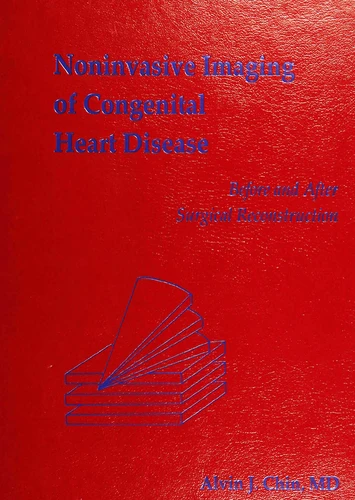Noninvasive Imaging of Congenital Heart Disease Before and After Surgical Reconstruction
Par :Formats :
Disponible dans votre compte client Decitre ou Furet du Nord dès validation de votre commande. Le format ePub est :
- Compatible avec une lecture sur My Vivlio (smartphone, tablette, ordinateur)
- Compatible avec une lecture sur liseuses Vivlio
- Pour les liseuses autres que Vivlio, vous devez utiliser le logiciel Adobe Digital Edition. Non compatible avec la lecture sur les liseuses Kindle, Remarkable et Sony
 , qui est-ce ?
, qui est-ce ?Notre partenaire de plateforme de lecture numérique où vous retrouverez l'ensemble de vos ebooks gratuitement
Pour en savoir plus sur nos ebooks, consultez notre aide en ligne ici
- FormatePub
- ISBN978-0-578-48616-1
- EAN9780578486161
- Date de parution14/05/2019
- Protection num.pas de protection
- Infos supplémentairesepub
- ÉditeurEditeurs divers USA
Résumé
Focusing on the use of two-dimensional and color flow Doppler echocardiography in characterizing the morphology of congenital heart disorders before and after surgical reconstructive procedures, this 2019 eBook release provides new illustrations of the technique of imaging patients with dextrocardia, additional text on the topic of criss-cross hearts, as well as many other refinements. Derived from a yearly lecture series for cardiology fellows, junior faculty, and sonographers, the chapters are arranged in order to serve as a companion to the cardiac pathologist's teaching of the segmental approach to the anatomic classification of congenital heart defects.
The quantitative characterization of the pathophysiology of these conditions are discussed in particular detail in two chapters on pre- and post-surgical magnetic resonance imaging. The author was privileged to have been a part of a pioneering team of cardiac surgeons, anesthesiologists, cardiologists, and cardiac anatomists, who coalesced in 1984-1989 around the then-unsolved problem of how to rescue newborns with hypoplastic left heart syndrome, the commonest lethal congenital heart disorder in infancy.
Non-invasive imaging played a major role in the story of how surgical reconstructions were successfully devised for this and other complex lesions. In the ensuing decade, precise morphologic phenotyping of human cardiovascular anomalies using echocardiography became additionally important to the fields of human genetics and mammalian developmental biology. For example, ultrasound is the most widely employed methodology for in vivo cardiovascular phenotyping of mouse mutant lines.
The quantitative characterization of the pathophysiology of these conditions are discussed in particular detail in two chapters on pre- and post-surgical magnetic resonance imaging. The author was privileged to have been a part of a pioneering team of cardiac surgeons, anesthesiologists, cardiologists, and cardiac anatomists, who coalesced in 1984-1989 around the then-unsolved problem of how to rescue newborns with hypoplastic left heart syndrome, the commonest lethal congenital heart disorder in infancy.
Non-invasive imaging played a major role in the story of how surgical reconstructions were successfully devised for this and other complex lesions. In the ensuing decade, precise morphologic phenotyping of human cardiovascular anomalies using echocardiography became additionally important to the fields of human genetics and mammalian developmental biology. For example, ultrasound is the most widely employed methodology for in vivo cardiovascular phenotyping of mouse mutant lines.
Focusing on the use of two-dimensional and color flow Doppler echocardiography in characterizing the morphology of congenital heart disorders before and after surgical reconstructive procedures, this 2019 eBook release provides new illustrations of the technique of imaging patients with dextrocardia, additional text on the topic of criss-cross hearts, as well as many other refinements. Derived from a yearly lecture series for cardiology fellows, junior faculty, and sonographers, the chapters are arranged in order to serve as a companion to the cardiac pathologist's teaching of the segmental approach to the anatomic classification of congenital heart defects.
The quantitative characterization of the pathophysiology of these conditions are discussed in particular detail in two chapters on pre- and post-surgical magnetic resonance imaging. The author was privileged to have been a part of a pioneering team of cardiac surgeons, anesthesiologists, cardiologists, and cardiac anatomists, who coalesced in 1984-1989 around the then-unsolved problem of how to rescue newborns with hypoplastic left heart syndrome, the commonest lethal congenital heart disorder in infancy.
Non-invasive imaging played a major role in the story of how surgical reconstructions were successfully devised for this and other complex lesions. In the ensuing decade, precise morphologic phenotyping of human cardiovascular anomalies using echocardiography became additionally important to the fields of human genetics and mammalian developmental biology. For example, ultrasound is the most widely employed methodology for in vivo cardiovascular phenotyping of mouse mutant lines.
The quantitative characterization of the pathophysiology of these conditions are discussed in particular detail in two chapters on pre- and post-surgical magnetic resonance imaging. The author was privileged to have been a part of a pioneering team of cardiac surgeons, anesthesiologists, cardiologists, and cardiac anatomists, who coalesced in 1984-1989 around the then-unsolved problem of how to rescue newborns with hypoplastic left heart syndrome, the commonest lethal congenital heart disorder in infancy.
Non-invasive imaging played a major role in the story of how surgical reconstructions were successfully devised for this and other complex lesions. In the ensuing decade, precise morphologic phenotyping of human cardiovascular anomalies using echocardiography became additionally important to the fields of human genetics and mammalian developmental biology. For example, ultrasound is the most widely employed methodology for in vivo cardiovascular phenotyping of mouse mutant lines.



